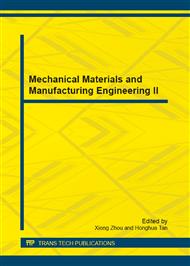p.31
p.37
p.43
p.48
p.54
p.60
p.69
p.74
p.79
Study of MB3 Mg Alloy by MAO Process in Different Electrolyte
Abstract:
Micro-arc oxidation (MAO) coatings were synthesized on MB3 magnesium alloy substrate. Two different electrolyte (Ⅰ) and electrolyte (Ⅱ) were adopted, and the performance of ceramic coatings was compared. The morphology feature, phase composition, and chemical composition of the formed coatings were studied by metallographic microscope, scanning electron microscopy (SEM), energy disperse spectroscopy (EDS), XRD, respectively. The corrosion resistance of the coatings was evaluated by salt spray test. The research results show that, the starting and terminal voltage are different during the oxidation process, they are 220V and 375V in the electrolyte (Ⅰ), and 150V and 270 V in electrolyte (Ⅱ). After MAO, The sample surface in electrolyte (Ⅰ) is light gray, and looks tender and smooth. The ceramic coatings obtained in electrolyte (Ⅱ) are relative rough and white in colour. But MAO coatings obtained in electrolyte (Ⅱ) has higher deposition rate. Salt spray test show the corrosion resistance of samples obtained in electrolyte (Ⅱ) are better than those in electrolyte (Ⅰ), which is related to the thickness of the MAO coatings.
Info:
Periodical:
Pages:
54-59
Citation:
Online since:
December 2012
Authors:
Price:
Сopyright:
© 2013 Trans Tech Publications Ltd. All Rights Reserved
Share:
Citation:


